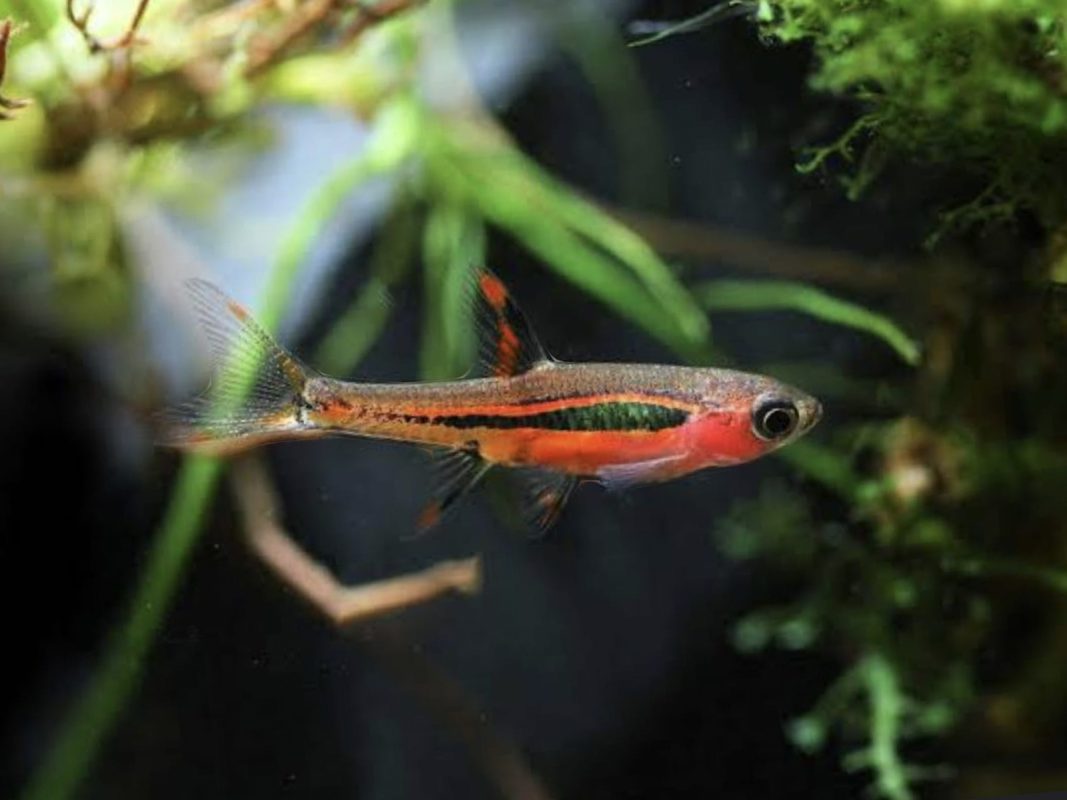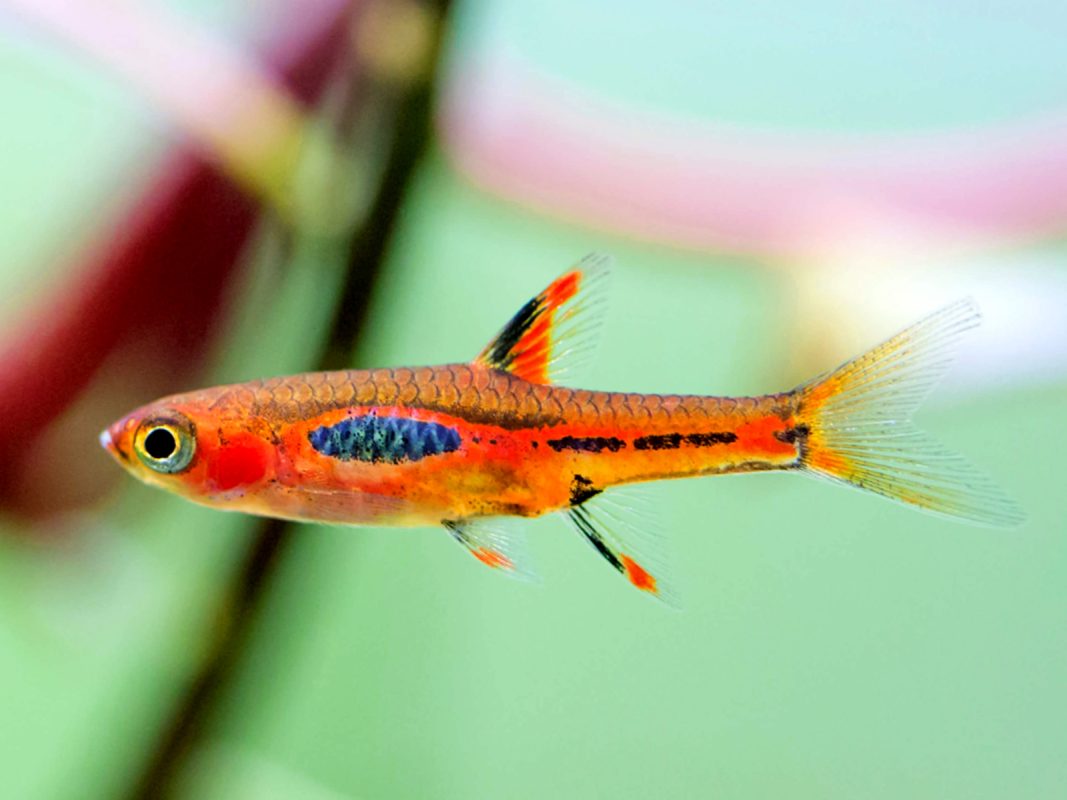Blogs
Phoenix Rasboras: A Comprehensive Guide to Adding Color and Life to Your Aquarium
Dive into the vibrant world of the Phoenix Rasbora (Boraras merah), a captivating species that injects a burst of color and liveliness into any freshwater aquarium. These tiny fish, reaching a maximum size of just under an inch, hail from the Indonesian region of Borneo, where they inhabit slow-flowing, blackwater streams and rivers. Their peaceful nature and stunning appearance make them an ideal choice for community tanks and shrimp enthusiasts alike.
Origin and Habitat
Natural Surroundings: A Glimpse into the Life of the Phoenix Rasbora
The Phoenix Rasbora originates from the Indonesian portion of Borneo, specifically the blackwater streams and rivers flowing through the island’s swampy forests. Due to their preference for slow-moving water, they occupy a specific niche in the ecosystem.
Adapting the Phoenix Rasbora’s Habitat to Your Aquarium
Mimicking the natural habitat of the Phoenix Rasbora is crucial for their well-being in captivity. Using a dark substrate, such as fine gravel or soil, recreates the riverbed they are accustomed to. Adding natural elements like twigs, leaf litter, and aquatic plants provides ample hiding places and simulates their natural environment. Lastly, keeping the lighting subdued will contribute to a comfortable environment for these sensitive fish.
Physical Description: Beauty in Miniature
The Phoenix Rasbora is a visual delight, boasting a deep red body color adorned with bold orangeish and black markings. This vibrant coloration is especially pronounced in males, who display a captivating ruby red hue. Females, while less ostentatious, still maintain a reddish-brown shade that complements the males’ vibrancy.

Water Parameters and Care
Creating the Ideal Aquatic Haven for Your Phoenix Rasbora
To ensure the well-being of your Phoenix Rasboras, maintaining stable water parameters is essential. pH: A range of 4-7 is ideal, mimicking the naturally acidic blackwater environment they inhabit. Temperature: An optimal range of 68-82.5 °F replicates their preferred tropical climate. Hardness: Aim for low water hardness to mimic the condition of their natural habitat.
Feeding Your Phoenix Rasbora: A Culinary Journey
Phoenix Rasboras are omnivorous, with a diet consisting of both plant and animal matter. To maintain their health and vitality, provide a varied diet rich in nutrients. Their diet should include high-quality flake food, pellets, and live or frozen foods such as brine shrimp, Daphnia, and microworms.
Social Harmony: Selecting Compatible Tank Mates
Phoenix Rasboras are peaceful community fish that thrive in groups of at least 6-8 individuals. Selecting compatible tank mates is essential for their comfort and well-being. Ideally, choose other calm, peaceful species that thrive in similar water parameters. Suitable companions include bottom dwellers like panda Corydoras and kuhli loaches, top dwellers like hatchetfish and dwarf gourami, and other small schooling fish like tetras and harlequin rasboras. These harmonious pairings create a vibrant and serene underwater community.
Breeding: Nurturing the Next Generation
Breeding Phoenix Rasboras can be a rewarding experience, as they readily reproduce in captivity. For successful breeding, set up a dedicated breeding tank with ideal water parameters and provide tiny foods for the resulting fry. This delicate process requires patience and attention to detail.
Aquarium Setup and Maintenance
Furnishing Your Phoenix Rasbora’s Home: A Guide to Aquarium Setup
Creating a cozy and stimulating environment for your Phoenix Rasboras is crucial. Invest in a tank of at least 10 gallons to accommodate their active nature and provide ample swimming space. A sponge filter ensures gentle filtration without overwhelming these delicate fish. Additionally, regular water changes are essential to maintain water quality and prevent the buildup of harmful waste products.
Differentiating the Phoenix Rasbora from its Cousins
The Phoenix Rasbora is closely related to the Chili Rasbora, and their resemblance can sometimes lead to confusion. However, close observation reveals distinct differences. The Phoenix Rasbora exhibits a more pronounced red coloration, particularly in males, while the Chili Rasbora leans towards a more orange hue. Additionally, the Phoenix Rasbora displays a combination of black and red markings, while the Chili Rasbora bears predominantly black markings. Recognizing these subtle differences helps ensure accurate identification.
Health and Lifespan: Ensuring a Long and Healthy Life
Safeguarding Your Phoenix Rasbora’s Health: Preventing Common Ailments
Maintaining a clean and healthy aquarium environment is the primary defense against potential health issues. Regular water changes, along with adequate filtration and a balanced diet, go a long way in preventing illness. Additionally, monitor your fish for any behavioral changes or physical signs of distress, such as loss of appetite or discoloration. Early intervention leads to faster recovery and better overall health.
Lifespan Expectations: Cherishing Every Moment
With proper care, Phoenix Rasboras can live for an average of 3-5 years in captivity. However, factors such as genetics, water quality, and diet can influence their lifespan. Creating an optimal environment and providing meticulous care extends their lifespans and allows you to enjoy their vibrant presence for longer.
Acquiring Your Phoenix Rasbora: Bringing Home Your New Companions
Finding Your Ideal Phoenix Rasboras: A Guide to Acquisition
Phoenix Rasboras are readily available in most aquarium stores and online retailers. Opt for reputable sources to ensure the health and quality of your fish. When choosing your Rasboras, observe their activity level and overall appearance to select healthy individuals. Upon arrival, introduce them to their new environment gradually to minimize stress and allow them to acclimate to their surroundings.
FAQs
1. What are the ideal water parameters for keeping Phoenix Rasboras?
The ideal water parameters for Phoenix Rasboras are a pH of 4-7, a temperature of 68-82.5 °F, and low water hardness.
2. Can Phoenix Rasboras be kept in a community tank?
Yes, Phoenix Rasboras are peaceful fish that can be kept in a community tank with other calm, compatible species.
3. What is the typical lifespan of a Phoenix Rasbora?
With proper care, Phoenix Rasboras can live for 3-5 years in captivity.
4. What are some common tank mates for Phoenix Rasboras?
Suitable tank mates for Phoenix Rasboras include panda Corydoras, kuhli loaches, hatchetfish, dwarf gourami, tetras, and harlequin rasboras.
5. How do I differentiate between a Phoenix Rasbora and a Chili Rasbora?
Phoenix Rasboras have a more pronounced red coloration, especially in males, and display a combination of black and red markings. Chili Rasboras lean towards an orange hue and predominantly black markings.
Conclusion
The Phoenix Rasbora, with its captivating appearance, peaceful nature, and relatively easy care requirements, makes an excellent addition to any freshwater aquarium. By providing a suitable environment and attentive care, you can enjoy the beauty and活力 of these vibrant fish for years to come.

